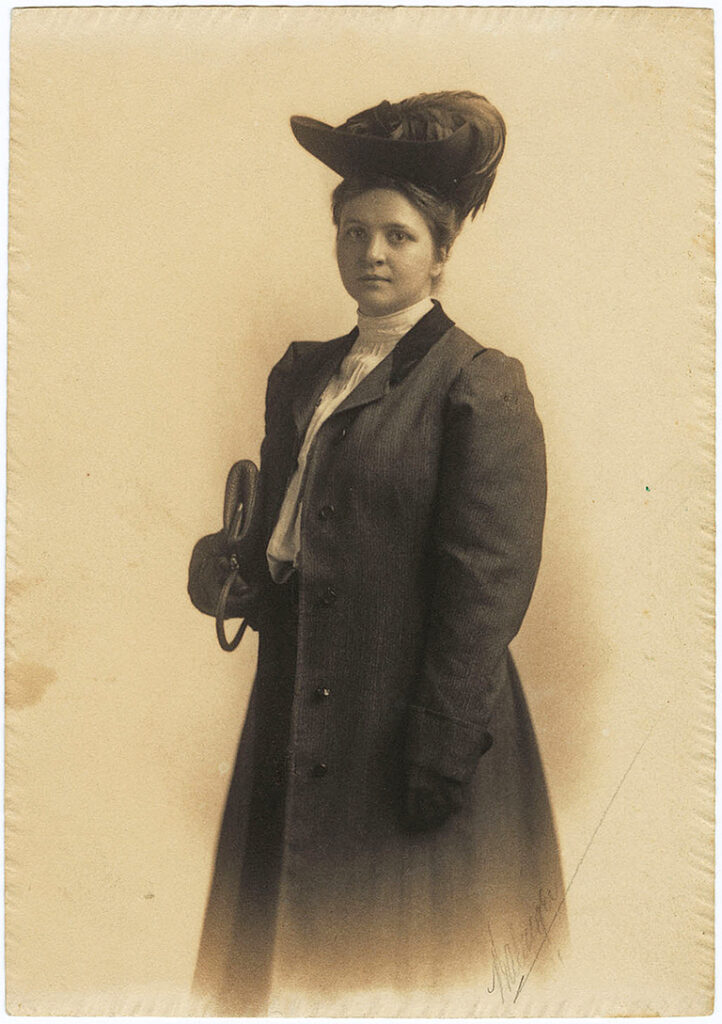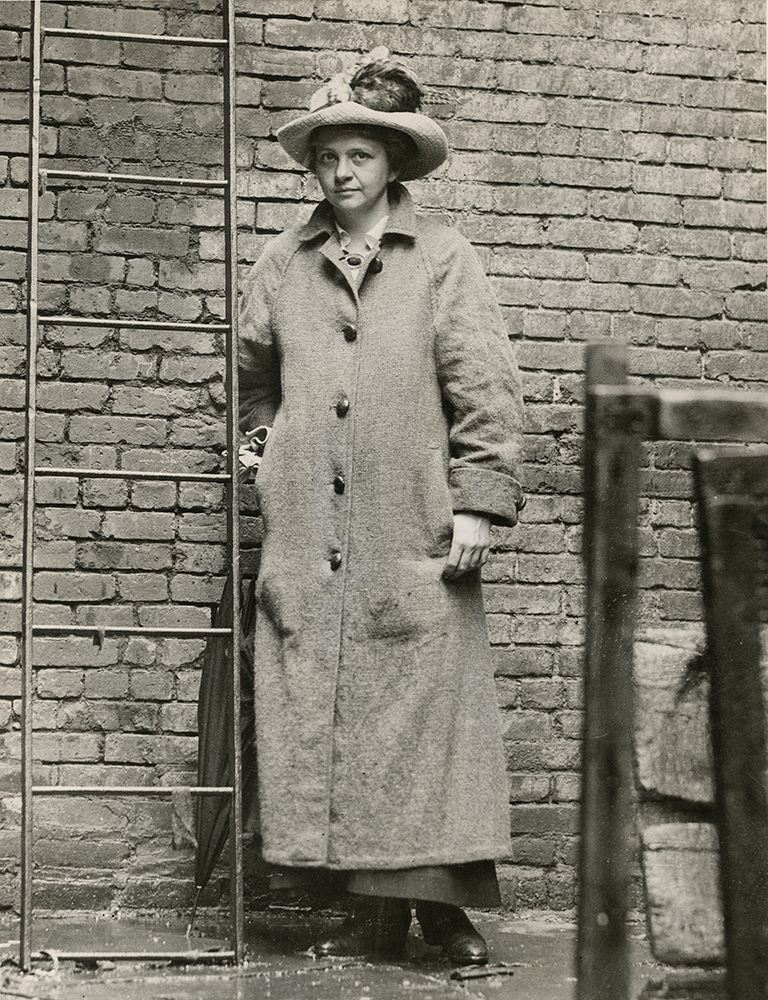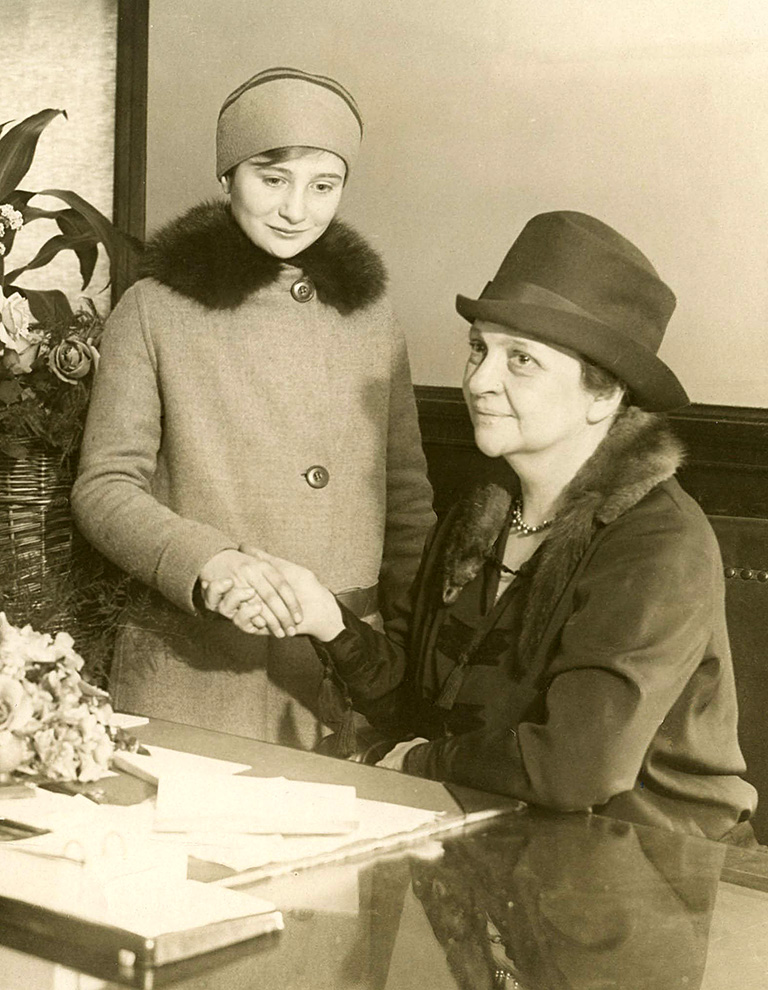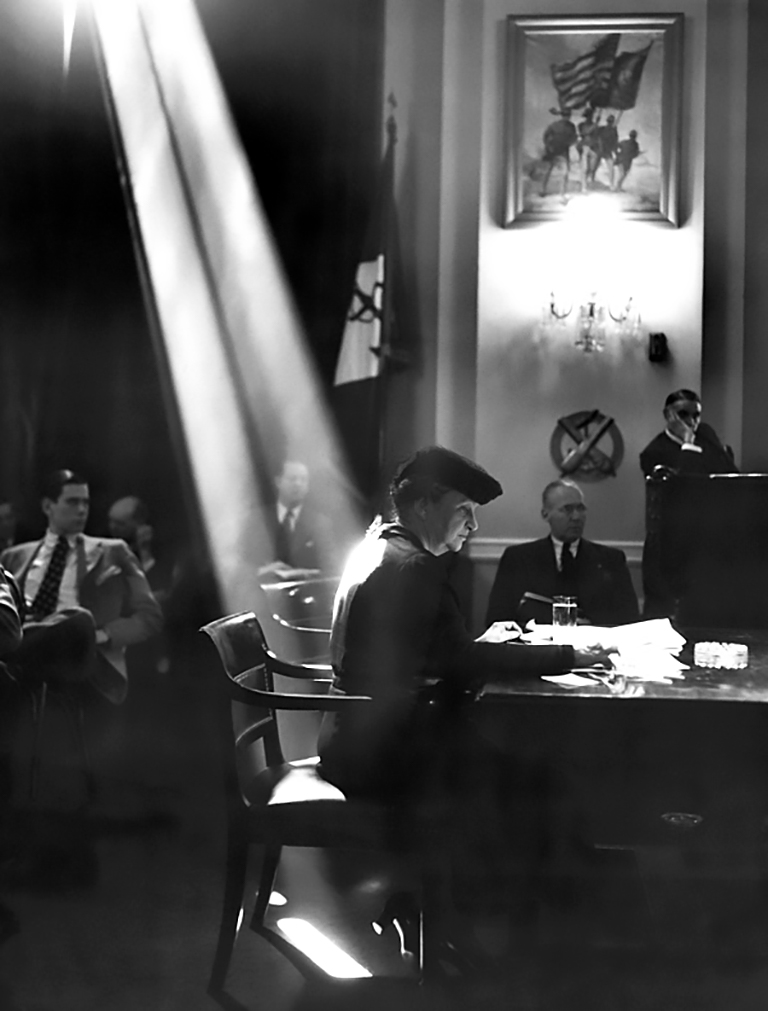Her Life
THE WOMAN BEHIND THE NEW DEAL
“The people are what matter to government, and a government should aim to give all the people under its jurisdiction the best possible life.”
Frances Perkins, FDR’s Secretary of Labor and the first woman to serve as a cabinet secretary, was the driving force behind the New Deal, credited with formulating policies to shore up the national economy following the nation’s most serious economic crisis and helping to create the modern middle class. She was in every respect a self-made woman who rose from humble New England origins to become America’s leading advocate for industrial safety and workers’ rights.
Click a time period below to learn more about Frances Perkins’ life.
CHRONOLOGY
1933 - 1945
Major accomplishments of her 12-year tenure as Secretary of Labor included her work on:
Social Security Act:
Directed the development and passage of landmark law establishing old age pensions, unemployment insurance, and survivor benefits
CCC, NRA, PWA, WPA:
Instrumental in creating major New Deal jobs programs and U.S. Employment Service (created by Wagner-Peyser Act)
Fair Labor Standards Act:
Maximum hours and minimum wages in all interstate industries; restrictions on child labor
Bureau of Labor Standards:
Industrial accident and occupational disease prevention; working condition improvements through research and union/employers conferences
National Labor Relations Act:
Right of workers to organize and collective bargaining
International Labor Organization (ILO):
Coordinated effort for U.S. membership
Immigration:
Saved thousands of refugees by limiting deportations to Nazi Germany
1945 - 1952
Appointed to U.S. Civil Service Commission by President Harry S. Truman.
1946
Wrote best-selling biography of FDR titled “The Roosevelt I Knew.”
1955 - 1965
1955-1965 Visiting professor at Cornell University’s School of Industrial and Labor Relations.
1955 - 1965
1965 Died in New York City, buried in Newcastle, Maine.

1880 - 1898 : Childhood & Youth
“I am extraordinarily the product of my grandmother.”
Frances Perkins was born Fannie Coralie Perkins in Boston in 1880, but her roots were in Maine. Her mother, Susan E. Bean, came from Bethel, and her father Frederick Perkins was born and raised in Newcastle, on land along the Damariscotta River where his ancestors first settled in the 1750s. The family farmed the land and also operated a brickyard at the river’s edge. After the Civil War, economic times became more difficult in rural Maine, and the brickyard began to falter. Frederick and his younger brother moved to Massachusetts for better prospects, while the oldest son remained in Newcastle to manage the farm. In 1882, Frederick Perkins moved his young family from Boston to Worcester, where he opened a paper goods business – a business that remains successful to this day. He maintained close ties to Newcastle, however, and Fanny, as she was known to the family, spent her childhood summers with her grandmother on the farm in Newcastle. Frequently in winters, her grandmother and uncle would stay with the Perkins family in Worcester.
Cynthia Otis Perkins, then a widow in her seventies, was the center of the family, “an extremely wise woman – worldly wise, as well as spiritually wise,” Frances later explained. “I am extraordinarily the product of my grandmother,” whose wisdom guided her throughout her life.
It was at the Brick House, built in 1837 as a wedding gift for her grandparents, that Fanny heard stories about the French and Indian War, when the Perkins family maintained a garrison by the river to shelter the community in case of trouble. She also learned of life before the Revolution and of her Otis family relatives who had played a major part in the colonists’ fight for independence. These stories were passed down by Cynthia’s mother Thankful Otis, who spent her last years in the house. In the summer following Fanny’s fifteenth birthday, Cynthia’s cousin, Union General Oliver Otis Howard, first head of the Freedmen’s Bureau and founder of Howard University, visited the Brick House. Because Howard had lost his right arm in the war, Fanny was enlisted as his secretary.
Thus, Fanny was raised with a deep appreciation of history and pride in her patriot ancestry. She came of age understanding her New England heritage and adopting the Yankee values that were the core of that heritage – frugality, ingenuity, tenacity and self-reliance – as well as a belief that the new nation, only a century old at her birth, held opportunities for all who sought and were willing to work for them. Her life would take her far beyond the humble Maine farm, but it is there that she returned year after year for rest and rejuvenation.
Perkins household in Worcester was strict, conservative and Republican. Fanny and her sister Ethel, four years her junior, were restricted largely to the people and events within their house and the nearby Plymouth Congregational Church. It was only when Fanny entered school that she encountered poverty. When she asked her parents why nice people could be poor, they gave her the accepted answers of the day: that poverty was the result of alcohol or laziness. Her father told her that little girls shouldn’t concern themselves with such things. Frederick Perkins read to the family in Greek and gave Fanny lessons in Greek grammar when she was only eight. He also taught her to read at an early age and encouraged her interest in classical literature. Although it was unusual for young women to attend college at that time, it was always assumed that Fanny would do so.
She graduated from the college preparatory curriculum at Worcester’s Classical High School and then enrolled in Mount Holyoke College, fifty miles away in South Hadley, Massachusetts.
1898 - 1902 : Mount Holyoke
“Being a woman has only bothered me in climbing trees.”
Founded in 1837, Mount Holyoke is the nation’s oldest continuing institution of higher education for women. Its founder, Mary Lyon, believed that women should be educated, but with education came responsibility. “Education was to fit one to do good.” “Go where no one else will go, do what no one else will do,” she advised Mount Holyoke’s young women. This sense of purpose clearly foretold the remarkable career that Fanny Perkins would eventually pursue.
At Mount Holyoke, Fanny Perkins, known as “Perk” to her classmates, came under the demanding tutelage of professors who insisted she enroll in only the most rigorous courses. Fanny majored in physics, with minors in chemistry and biology. She was a popular student, became class president her senior year and permanent class president upon graduation. It was in her final semester, however, that she took a course in American economic history that would have the most profound impact on her life. Taught by historian Annah May Soule, the course concerned the growth of industrialism in England and America. Professor Soule required her students to visit the mills along the Connecticut River in neighboring Holyoke to observe working conditions there.
Of this experience, Frances Perkins later said, “From the time I was in college I was horrified at the work that many women and children had to do in factories. There were absolutely no effective laws that regulated the number of hours they were permitted to work. There were no provisions which guarded their health nor adequately looked after their compensation in case of injury. Those things seemed very wrong. I was young and was inspired with the idea of reforming, or at east doing what I could, to help change those abuses.”
Fanny’s fellow students organized a chapter of the National Consumers League and, in February of 1902, invited its executive secretary, Florence Kelley, to speak at Mount Holyoke. Later Frances Perkins told a friend that Kelley’s speech “first opened my mind to the necessity for and the possibility of the work which became my vocation.”
1902 - 1910 : Further Education & Early Employment
“I had to do something about unnecessary hazards to life, unnecessary poverty. It was sort of up to me.”
When Fanny Perkins graduated from Mount Holyoke in 1902, her parents intended that she live at home and take a teaching position, or perhaps find work with the church, until a suitable marriage prospect appeared. Fanny had other ideas. When her efforts to seek employment in social work were unsuccessful, she began reading materials in the field, including Jacob Riis’ 1890 depiction of life in New York’s slums, How the Other Half Lives. Ultimately, she left Worcester for a teaching position at Ferry Hall, an elite school for girls in Lake Forest, Illinois. Further demonstrating her independence, she changed her name and her religious affiliation from the Congregational Church of her forebears. In June of 1905, she was confirmed in the Episcopal faith as Frances Perkins. The church and her belief in the need to make the Kingdom of God in this world would be a source of strength and commitment throughout her life.
While in Chicago, Frances Perkins spent her free time and vacations working at Chicago Commons and Hull House, two of the oldest and most well-known settlement houses in the country. Working with the poor and the unemployed, she became convinced of her vocation. “I had to do something about unnecessary hazards to life, unnecessary poverty. It was sort of up to me. This feeling … sprang out of a period of great philosophical confusion which overtakes all young people.”
In 1907, Frances Perkins accepted a position as general secretary of the Philadelphia Research and Protective Association, a new organization whose goal was to thwart the diversion of newly arrived immigrant girls, including black women from the South, into prostitution. She studied sociology and economics at the University of Pennsylvania’s Wharton School with the progressive economist Simon N. Patten. In 1909, she began a fellowship with the New York School of Philanthropy, investigating childhood malnutrition among school children in New York’s Hell’s Kitchen, and enrolled as a master’s degree candidate in sociology and economics at Columbia University. Her research project, entitled “A Study of Malnutrition in 107 Children from Public School 51,” became her master’s thesis.
In 1910, fulfilling an objective she set for herself eight years before, Frances Perkins became Executive Secretary of the New York City Consumers League, working directly with Florence Kelley, the woman whose speech at Mount Holyoke had set the course of her career. Her work focused on the need for sanitary regulations for bakeries, fire protection for factories, and legislation to limit the working hours for women and children in factories to 54 hours per week. Much of her work was in Albany, in the halls and committee rooms of the state capitol. There, with the guidance and counsel of Assemblyman Al Smith, Senator Robert Wagner and newfound Tammany Hall allies, Frances Perkins learned the skills of an effective lobbyist for labor and social reforms.
1910 onward : Frances Perkins & Family Life
Frances Perkins met Paul Caldwell Wilson around 1910. Paul came from a wealthy merchant family and was working as a financial statistician at a non-profit organization. They began as friends and frequent correspondents before starting a romantic relationship. After getting married in 1913, Paul began work on John Purroy Mitchell’s successful campaign to become New York City Mayor. He and Frances Perkins ran in similar political and social circles, but she kept her surname, which was incredibly rare and controversial for the time. She wanted to preserve her own identity and had already made a name for herself.
She and Paul initially prospered together in New York City, sharing connections in their overlapping careers and living in an elegant townhouse. Nevertheless, life took a turn in 1915. Paul’s career was starting to occupy more time, and Frances Perkins took on the taxing role of running their highly regimented household. She soon discovered Paul was having an affair and, whether or not due to this revelation, planned to leave him; however, she discovered that she was pregnant and remained in the marriage.
Frances Perkins experienced a miscarriage of her first pregnancy but soon became pregnant again. During her second pregnancy, she was very ill, developing a dangerous condition called pre-eclampsia, and she prepared for her possible death. After a cesarean section, her child was stillborn.
Frances Perkins became pregnant again and gave birth to her daughter, Susanna Perkins Wilson, on December 30, 1916. Her marriage with Paul momentarily improved, but one year after Susanna’s birth, he displayed symptoms of mental illness. He became very temperamental, drank excessively, and lost his inheritance to bad investments. John Purroy Mitchell lost the next election, leaving Paul unemployed as a political adviser. Due to his so-called manic depression, which was misunderstood at the time, he did not obtain another job and was often unable to help with household responsibilities. He was in and out of sanitariums and Frances became solely responsible for taking care of the family. After a lifelong struggle with his mental health, Paul had a stroke on December 31, 1952 and passed away.
Susanna experienced similar mental health challenges throughout her life. She and Frances Perkins often argued. Their relationship briefly improved upon Susanna’s second marriage and the birth of her son, Tomlin, in 1954; but by the time of Frances Perkins’ death in 1965, Susanna and Frances were mostly estranged. Frances Perkins remained an important part of Tomlin’s life until her death.
1911 - 1918 : The Day the New Deal Was Born
On March 25, 1911, Frances Perkins was having tea with friends in New York City’s Washington Square when the group heard fire engines. Running to the scene of the fire, Frances Perkins witnessed in horror as 47 workers – mostly young women – jumped from the eighth and ninth floors of the building to their deaths on the street below. In all, 146 died as flames engulfed the upper three stories of the building. The fire at the Triangle Shirtwaist Factory was, she later proclaimed, “the day the New Deal was born.” In response to the fire, a citizen’s Committee on Safety was established to recommend practices to prevent a further tragedy in the city’s factories.
At the suggestion of Theodore Roosevelt, Frances Perkins was hired as the group’s executive secretary. One of the Committee’s first actions was to seek a state commission to investigate and make legislative recommendations. The Factory Investigating Commission’s mandate was much broader than originally contemplated: to study not only fire safety, but other threats to the health and well-being of industrial workers and the impact of those threats upon families. Frances Perkins, by that time a recognized expert in the field of worker health and safety, served as expert witness, investigator and guide, leading legislators on inspections of the state’s factories and worksites to view first-hand the dangers of unfettered industrialism. The Commission’s work resulted in the most comprehensive set of laws governing workplace health and safety in the nation.
These new laws became a model for other states and the federal government. Reflecting on her years as lobbyist, investigator and researcher, Frances Perkins later said, “The extent to which this legislation in New York marked a change in American political attitudes and policies toward social responsibility can scarcely be overrated. It was, I am convinced, a turning point.”
1918 - 1928 : Industrial Commission & Gov. Al Smith
The gubernatorial election of 1918 was the first in which women in New York had the right to vote. Frances Perkins campaigned hard to capture the women’s vote for Al Smith, her friend and ally during her prior work in Albany. Shortly after his election as governor, Smith appointed her to a vacant seat on the New York State Industrial Commission. She was the first woman to be appointed to an administrative position in New York state government and, with an annual salary of $8000, the highest paid woman ever to hold public office in the United States. Smith’s goal was to weed out the incompetence and corruption in the state labor department so that Frances and her fellow commissioners would enforce the laws the Factory Investigating Commission had brought about. For Smith’s four terms as governor, Frances Perkins served as his closest labor advisor, working with him to build on the legislative accomplishments of the prior decade. In his final term, he appointed her to chair the Industrial Commission.
1928 - 1930 : Industrial Commissioner & Gov. Roosevelt
In the election of 1928, Smith lost his bid to become the nation’s president, and New York elected a new governor, Franklin D. Roosevelt. Roosevelt asked Frances Perkins to become the state’s Industrial Commissioner, with oversight responsibilities for the entire labor department. Soon, she became the most prominent state labor official in the nation, as she and Roosevelt searched for new ways to deal with rising unemployment. “We have awakened with a shock to the frightful injustice of economic conditions which will allow men and women who are willing to work to suffer the distress of hunger and cold and humiliating dependence. We have determined to find out what makes involuntary employment,” she said.
From her position in New York State, Frances Perkins worked with representatives of labor and industry to explore long-range programs to increase employment. She helped organize a conference on unemployment of the seven industrial states of the Northeast. She reorganized and expanded the state’s employment agencies, but increasingly, her focus was on devising a program of unemployment insurance. With her encouragement, Roosevelt became the first public official in the country to commit himself to unemployment insurance, and in 1930, he sent Perkins to England to study the British system. In October, she returned, armed with recommendations for an American version of that program.
1933 - 1945 : Secretary Perkins & President FDR
“I came to Washington to work for God, FDR, and the millions of forgotten, plain, common working men.”
With the election of Franklin D. Roosevelt as President in 1932, Frances Perkins’ years in public service in New York were over. Soon, however, the policies and programs Frances Perkins had advanced for the State of New York were about to be tested for all the nation.
When, in February, 1933, President-elect Roosevelt asked Frances Perkins to serve in his cabinet as Secretary of Labor, she outlined for him a set of policy priorities she would pursue: a 40-hour work week; a minimum wage; unemployment compensation; worker’s compensation; abolition of child labor; direct federal aid to the states for unemployment relief; Social Security; a revitalized federal employment service; and universal health insurance. She made it clear to Roosevelt that his agreement with these priorities was a condition of her joining his cabinet. Roosevelt said he endorsed them all, and Frances Perkins became the first woman in the nation to serve in a Presidential cabinet.
From her earliest days in the Roosevelt cabinet, Frances Perkins was a forceful advocate for massive public works programs to bring the nation’s unemployed back to work. Within a month of Roosevelt’s inauguration, Congress enacted legislation establishing the Civilian Conservation Corps, which Roosevelt asked Perkins to implement. Roosevelt also asked her to present a plan for an emergency relief program, and she delivered a young social worker from New York named Harry Hopkins who had visited Frances in Washington with his own proposal. That proposal became embodied in the Federal Emergency Relief Administration, which Hopkins led. Before Roosevelt presented his final One Hundred Days legislation to the Congress, the National Industrial Recovery Act, Perkins convinced him to allocate $3.3 billion for public works from the moneys appropriated. Serving as a member of the Special Board for Public Works, Perkins helped to ensure that money was spent on socially useful projects: schools, roads, highway, housing projects and post offices. Public works construction employed as many as 1.5 – 2 million people in 1934.
In 1934, Roosevelt appointed Frances Perkins to head a Committee on Economic Security, where she forged the blueprint of legislation finally enacted as the Social Security Act. Signed into law by the President on August 14, 1935, the Act included a system of old age pensions, unemployment compensation, workers’ compensation and aid to the needy and disabled.
In 1938, Congress enacted the Fair Labor Standards Act, also crafted with the support of Perkins, establishing a minimum wage and maximum work hours and banning child labor.
At the time of Roosevelt’s death in April of 1945, Frances Perkins was the longest serving labor secretary and one of only two cabinet secretaries to serve the entire length of the Roosevelt Presidency. In 1944, a piece portraying Frances Perkins in Collier’s magazine described her accomplishments over the previous twelve years as “not so much the Roosevelt New Deal, as … the Perkins New Deal.” She had accomplished all but one of the items on the agenda she had presented to the newly elected President in February of 1933: universal access to health care.
1945 - 1965 : Continued Service & Later Years
“There is always a large horizon…. There is much to be done …. I am not going to be doing it! It is up to you to contribute some small part to a program of human betterment for all time.”
Before leaving the Department of Labor in June of 1945, Frances Perkins stood in the department’s auditorium, and while a full orchestra played, she shook the hands and personally thanked each one of the department’s 1800 employees. The following evening, she was honored at the Mayflower Hotel. The months that followed were busy, as she began writing The Roosevelt I Knew, a best-selling biography of FDR published in 1946, and serving as head of the American delegation to the International Labor Organization in Paris.
The following year, President Truman appointed her to the United States Civil Service Commission, a position she held until 1953. She then began a new career of teaching, writing and public lectures, ultimately serving until her death as a lecturer at Cornell University’s new School of Industrial Relations.
Frances Perkins suffered a stroke and died at Midtown Hospital in New York City on May 14, 1965, at the age of 85. She is buried alongside her husband, Paul Wilson, in the Glidden Cemetery on the River Road in Newcastle, Maine, a short distance from the Brick House, the place she always considered her home.
Click here to read her obituary in the New York Times, 1965 (author unknown)












